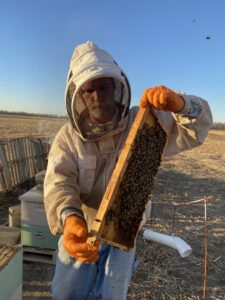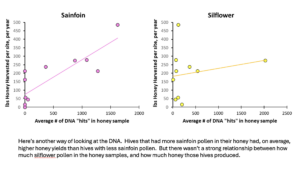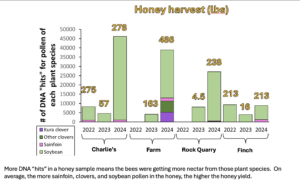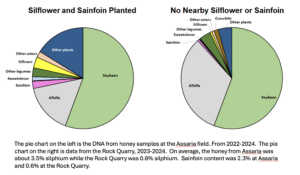Progress report for FNC23-1395
Project Information
My wife Judy Stovall and I are co-owners of AJ Honey Farms, LLC in Salina, KS. We have 6 years’ experience as beekeepers. I formerly served as a trainer for the Servicemember Agricultural Vocation Education (SAVE) program in Manhattan, KS. In addition to honey production, we specialize in crafting and selling spiced honey and beeswax products. We currently own about 50 healthy commercial beehives at 3 locations around Salina, KS.
Since 2021 we have had an agreement with The Land Institute, an NGO with sites in Salina and Lawrence, KS, in which we are allowed to keep our hives on their property in exchange for pollination services. We have collected data on our hives’ health and honey production in collaboration with scientists at The Land Institute.
Our company currently has basic honey extraction and bottling equipment, the equipment necessary to manage our commercial beehives, access to a commercial kitchen, and company vehicles to transport hives and beekeeping equipment and to travel to field sites. We also have equipment and supplies to produce beeswax products, such as candles, scented wax melts, and wax pucks. We sell our products at a storefront in Salina, KS, at local grocery stores in Salina, at farmers’ markets around the state of Kansas, and online through our own website and in collaboration with Perennial Pantry®. We also have an active Facebook, Instagram and TikTok accounts where we post information about our honey, products, and beekeeping adventures.
Beekeeping in rural Kansas is challenging, because much of the landscape is planted in wheat, sorghum, corn, and pasture grasses which do not provide nectar or quality pollen for honeybees. Also very few plants flower in July and August, creating a “dearth” in pollinator food which reduces honey production during the summer months. Many people try to keep bees to increase bee population and pollination services, but that’s only one small part of the equation. We need to find good pollinator crops that support bees, especially during the summer dearth, and we need to educate Kansas citizens on how to care for their bees and plant good flowering plants for bees.
At AJ Honey Farms we are passionate about planting perennial native plants and garden plants for pollinators, and placing our beehives near perennial flowers. Perennials are excellent for pollinators because they flower for a long period of time and produce nectar and pollen for bees year after year.
In 2021 we had great success with our honeybee hives that were set near fields of perennial crops planted by The Land Institute (TLI), a local nonprofit that is developing perennial grains. There are two major types of crops planted at that field, 6 acres of sainfoin and 4 acres of silflower. Sainfoin, Onybrychis viicifolia, is a perennial legume that blooms from May-June in Kansas. It’s on the list of the Xerces Society’s Top 100 Plants to plant for pollinators, and it makes very sweet honey. Silflower, Silphium integrifolium, is a native perennial sunflower being developed as an oilseed crop that flowers June-September, during the dearth. There is not much information about its honey production, but we observed our bees feeding on the flowers.
Our ten first-year hives produced 500 lb of honey, when often first year hives don’t produce any honey.
In 2022 we set out 20 more hives and began collecting data on them, with the help of Dr. Ebony Murrell at TLI. Ebony and I developed a weekly checklist to check the health of 10 hives. I did this for 10 hives at
TLI and 10 hives at a site north of Salina, where no silflower or sainfoin was planted. Between Jul 20-Oct 2 the hives at TLI produced 23% more capped supers of honey (~30 lbs. honey per super) per hive than the north Salina site. The TLI hives also produced 27.5 lbs. honey per hive between Jul-Oct, versus 19 lbs. honey per hive at the north Salina site.
For this grant, we want to do a bigger experiment where we add 10 new hives to each of our two current locations, plus 10 hives at two new locations. One location will be another TLI property where sainfoin and silflower are planted. Another will be a pasture field west of Salina, similar to our north Salina field, where no sainfoin or silflower are planted. We also want to run DNA tests on the honey samples from our hives to see how much the bees are feeding on sainfoin and silflower.
We also want to use our new store, and the fields at TLI, to run year-round classes on beekeeping. Our classes will be hands-on and outside working with bees whenever possible. Our goal is to teach Kansas beekeepers how to maintain healthy beehives, and which perennial plants to grow for healthy bees.
Objective 1: Test the honey production of beehives located next to fields of sainfoin and silflower, versus hives located in fields without these crops.
Objective 2: Train people in sustainable, profitable beekeeping using perennial flowering plants and best beekeeping practices.
Objective 3: Share findings of the silflower experiment and our training program approach at the Kansas Honey Producers Association meeting, at regional beekeeper association meetings in the state of Kansas, and through social media.
Research
I manage 40 hives split between four locations. This setup is to see how well the bees do and how much honey comes from sainfoin and silflowers, respectively.
I have 30 hives near the sainfoin and silflowers:
- Site 1: "Charlie’s" is the biggest farm involved. It has 40 Acres with Silflower and Sanfoin at that location.
- Site 2: "Farm" is TLI Farm. That location has 22 A of silflower and sainfoin.
I have 10 hives nowhere near these flowers. They are near milkweed to test out the results. I will have results from these hives in 2024 since milkweed was planted later in the fall.
- Site 3: "Rock Quarry" does not have either Sanfoin or Silflower. The property is in Salinas County, Kansas. It has alfalfa (which they let flower) and milkweed.
- Site 4: "Finch" does not have either Sanfoin or Silflower. The property is in Salinas County, Kansas. This location has lots of perennial natives and sunflower.
Conclusions:
- While we did observe honeybees feeding on silflower, and we observed its positive impacts in other ways, silflower doesn’t appear to be the biggest percentage of their diets. Importantly, bees had higher honey yields than when foraging on soybeans and clovers
- The bees also fed on sainfoin. While the sainfoin wasn’t a big % of their nectar source, hives that had more sainfoin pollen in their honey tended to have higher honey yields.
- One major advantage of having hives near sainfoin and silflower is that they don't have the dearth of pollen during the hot months. We are able to harvest from the sainfoin and silflower sites about mid-October because of that food source. We cannot get this additional harvest from the non-sainfoin and silflower sites.
Data is available in powerpoint slides, or here:
Educational & Outreach Activities
Participation summary:
Education:
In 2023, I hosted activities where I was able to show them how important the flowers and trees and pollens are for the bees.
-
- I worked with home school children (approximately 20 people),
- the FFA in Bennington (65 kids and 15 adults) and
- Minneapolis Schools (45 kids and 11 adults).
I also did the event at the fairgrounds in Salina, KS for 3 days showing the flowers and the bees and frames full of pollen and getting people involved in seeing the growth of bees using this flower and how the dearth isn't there when planting this type of flower.
In 2024, I hosted several events:
- 3 library presentations (32-35 per event)
I was also invited to present in UMinnesota, but weather cancelled the event.
Learning Outcomes
Project Outcomes
Honey from silflower and sainfoin is amazing: clear gold and we're finding that compared to honey from other flowers, it doesn't crystalize even over the long term (1-2 years and beyond).
Sainfoin has a flower aftertaste. People love it, and they specifically ask for when the honey from sainfoin will be available.
We have four new accounts that specifically want honey because it's silflower honey, including a mom and pop organic grocery, two bigger grocery stores, and one that just remodeled and added commercial kitchens (and they feature only our honey).
You have to plant silflower in November. One gentleman going to put 5 acres in Hayes, KS, which is exciting.



